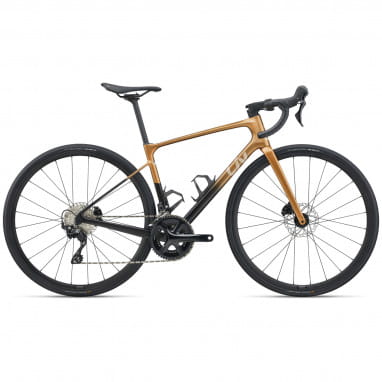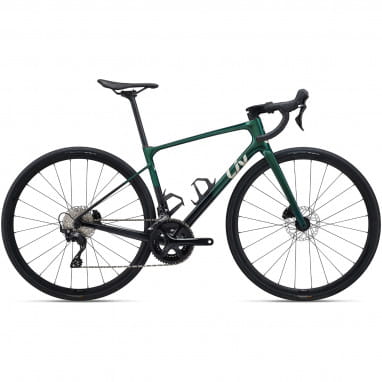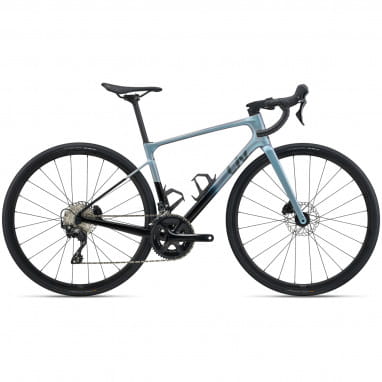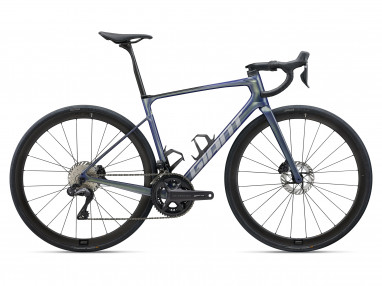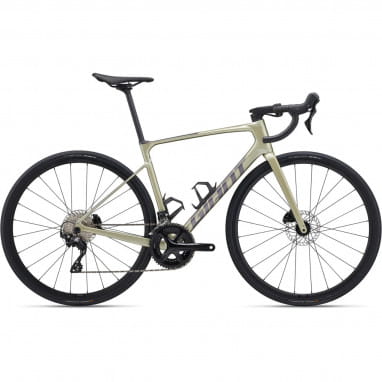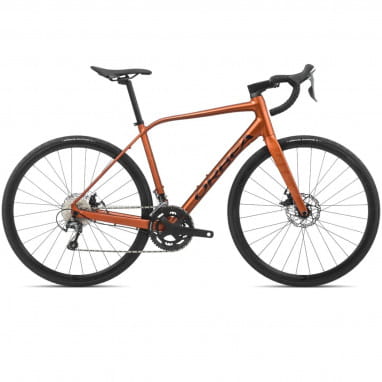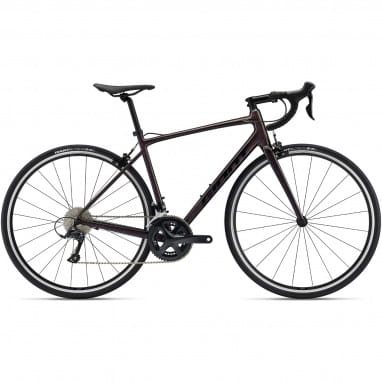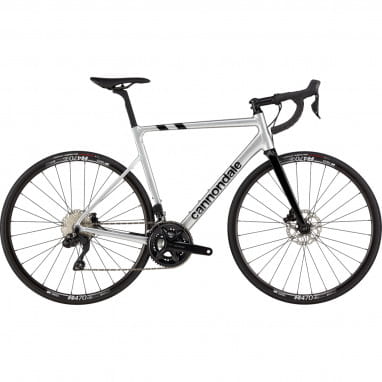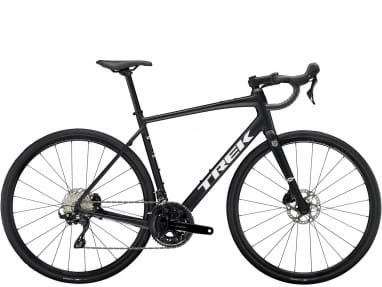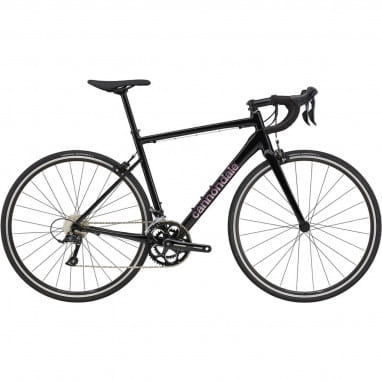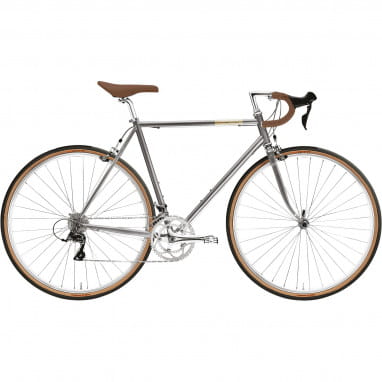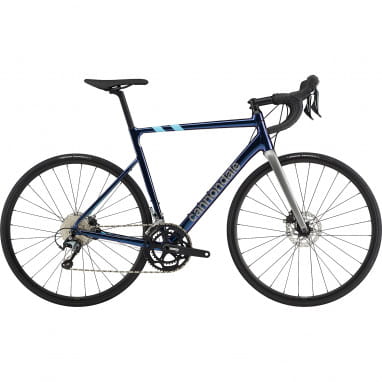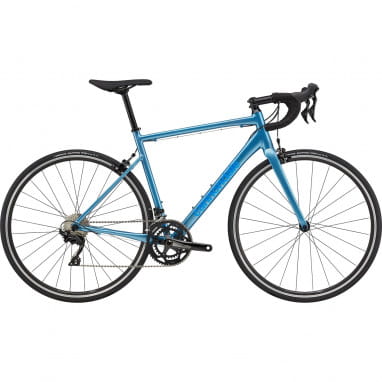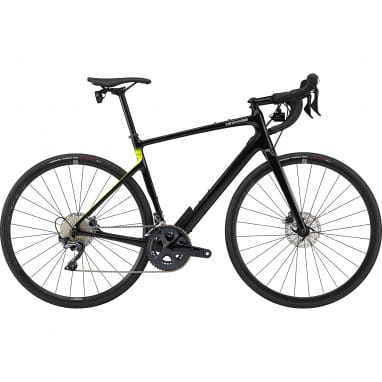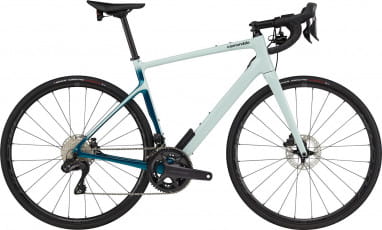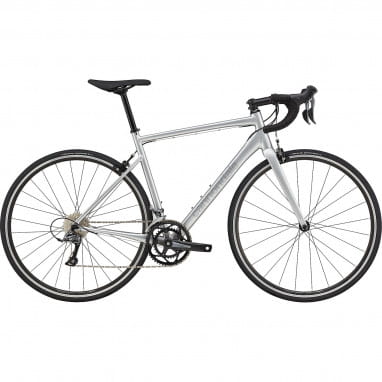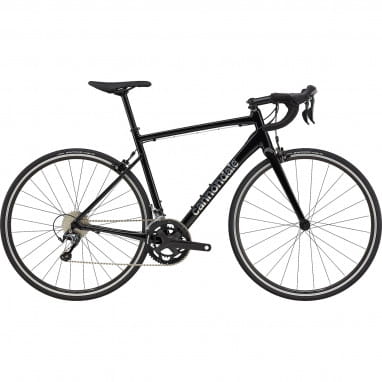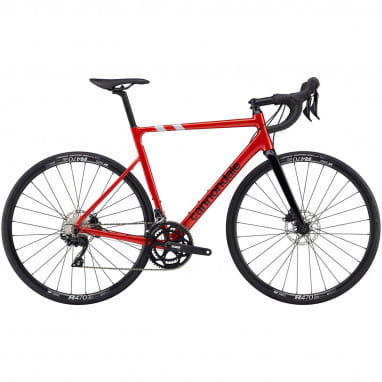But if it’s the bikes that get so fast themselves, what is left for the rider to do? The answer is quite simple: Of course it's your job to provide the propulsion, but the bicycle is built to take full advantage of your efforts and convert them into speed with no losses. The frame geometry, the material, the components, everything about a road bike is designed to make it as easy as possible for you to build up a constant and very high speed.
If you are already a passionate road cyclist and looking for a high-end new bike, Bike Mailorder is the right online store for you. But if you’re a rookie and want to buy your first road bike, we have plenty of entry level choices for you. To help you choose the right model, we’ll provide you with many interesting facts about road bikes, just keep reading, if you want to find out which road bike is the right bike for you.
This is a road bike - interesting facts about road bikes
With some bikes you can never be quite sure at first - is it a city bike or maybe a trekking bike? Or is it a mountain bike? In 99.8% of all cases you can immediately recognize a road bike, because it has a classic racing handlebar.
Then the next question would be: Is the bike in front of you a gravel bike, a road racing bicycle or a cyclocross bike? Here's how you can easily distinguish between the three very similar types of bikes.
Why do we speak of a "road racing bike”?
Gravel bikes, the off-road ready relatives of road bikes that have been rocking the market for a few years now, are the main culprit behind this designation. They look like a road bike, but the way they’re built and especially where they can go is significantly different from the properties of a classic road bike. Cyclocross bikes are also, strictly speaking, road bikes. So "road bike" became the generic term, “road racing bikes”, gravel bikes and cyclocross bikes are the subcategories we use to better explain the differences.
By the way, while it’s a “race bike” in German, in English you don’t speak of a "race bike", you ride a "road bike". This also draws a clear picture of where road racing bikes like to hang out: On the road.
Three characteristics define the road racing bike: light, clean, fast
If we take a closer look at the three main characteristics of a road bike, it quickly becomes clear what exactly defines a road bike:
Lightweight: Unfortunately we can't sell you road bikes by the kilo; we’d be broke in no time, because the bikes get lighter and lighter with each model year. Road bikes are the lightest bikes ever. Top models with carbon frames and a good complete road group weigh less than 10 kilos, the mega luxury models weigh less than 7 kilos! In general, bicycle parts are shedding weight with each new model year, but with road bikes you could almost talk about a "dieting mania". The race for the lightest carbon frames, the lightest components and the lightest add-on parts ensures that the bikes even fall short of the minimum competition weight of 6.8 kilograms prescribed by the UCI.
Clean: To make sure that the bikes can break weight records, components are shedding weight time and over again. All innovations that save weight are particularly popular on road bikes, electronic gear shifts, that don't need cables are a great example. The bicycle components that a bike simply can’t do without, are then often hidden from sight, or welded in one piece, you’ve certainly heard of an "integrated cockpit". On the other hand, Italian road bikes in particular often sport eye-catching paint jobs . After all, some kind of finish has to be added to a frame, so why not make it a colorful one?!
Quick: And why go to all these lengths? That's easy... to beat the inertial forces! Less bike means you get fast easier.
Modern road bike categories
Today, bikes are becoming more and more specialized, you can buy a perfect road racing bike for every plan, for every rider and for every route.
Road "race" bikes:
Road race bikes are the bikes that are propelled from one record to the next at the big bike races around the globe. These "race road bikes" are designed for perfect propulsion, acceleration and climbing. The UCI dictates 6.8kg minimum weight for a road bike, technically bikes can do even better (meaning lighter) than that. Comfort? Who needs comfort as soon as the speed rush kicks in?
Endurance road bikes:
An endurance road bike is somewhere between a gravel bike and a road bike. It offers a bit more comfort than a racer, you have more tire clearance, and the riding position feels more relaxed. These bikes are meant for long rides, i.e., sporty bike rides or training laps where tenths of a second don't matter.
Aero, time trial bike, triathlon bikes:
Of course, bikes such as aeros, time trial bikes, or triathlon bikes also are road bikes. However, these bikes are rather scarce because they're not meant for the masses. If you need a bike like this, you know everything you need to know already subject, so we won't explain anything further in this general buying guide.
Efficiency, no gimmicks
For your bike to be able to convert all its power into speed, it needs to be one thing above all: efficiency. Keeping the weight as low as possible isn't a bad thing, but there are other measures that get as much of your pedaling power down on the road as possible.
A road bike has no suspension whatsoever. Shocks, a suspension fork, thick tires, you'll look for all this equipment in vain, because all components that dampen not only absorb shocks from below, they also compensate for movements from above. Basically, pulverising your muscles' work is what they do!
To ensure that nothing gives way on your road bike, road bike frames are very stiff. Road bike frames with some flex offer more comfort, but are just less fast. That's why you'll only find steel frames on retro road bikes. Steel is more durable, but heavy and less stiff. Aluminum is much lighter, and also stiffer. Aluminum bikes are also rather inexpensive. The dream of all road cyclists, however, is a certainly carbon road bike. Carbon can take any shape, as a frame material, it is lightweight and extremely rigid.
The handlebar
We promised you criteria by which you can distinguish gravel bikes, cyclocross bikes and road racing bikes. But it's not the handlebars, all three usually have a drop bar, the classic road bike handlebar. There are many different terms for the various ups and downs of a road bike handlebar, these are the main ones:
Behind the stem (or in front of it, depending on from where you’re looking), i.e. the handlebar clamp, some drop bars are bent slightly back towards the saddle, then it has "backsweep". Some handlebars are slightly bent upwards at this point, the slight "rise" makes the driving posture less low and aerodynamic, but more comfortable.
A drop bar bends forward, this is the "reach" of the handlebar. Next, it bends downwards, the "drop" gives the whole handlebar its name, the term describes how far the handlebar is bent downwards. The lower the drop, the lower you sit when you hold on to the handlebar there. The handlebar's width tells you whether the handlebar suits your shoulder width. The narrower the road handlebars, the more aerodynamic the posture of your arms and shoulders.
> Click here for our road bike handlebars.
Road bike geometry
A road bike strives for top speeds, not riding comfort and a good view. It has lots of reach, a long distance between the saddle and handlebars. You ride low, with your nose close to the stem. That way you create as little drag as possible. The typical steep seat tube angle favors efficient pedaling, helps you build up speed quickly and easily maintain it over long distances. Many road bikes also have a steep head tube and thus a rather short wheelbase, the bikes are agile, some even find them rather “nervous”.
But even here the distinction is still difficult! Unless you’ve got a yard stick with you, it takes a practiced eye to tell a road geo from a gravel geo.
The tires
Here’s the solution: You can tell whether you are dealing with a road bike, a gravel bike or a cyclocross bike by looking at the tires. Gravel bikes and cyclocross bikes have wider tires, while road bikes have narrow tires. The reason, once again, is speed. Less material on the road means less rolling resistance. Gravel and cyclocross tires also have a clearly visible tread pattern, while road bike tires are smooth, which also reduces rolling resistance. For comparison, mountain bikes ride on the widest tires money can buy, 6cm and more, that's about 5cm more than road bike tires.
Road bike tires are generally very narrow. Of course, there are variations, trends and personal preferences, but 25mm tire widths are common. The narrow tires not only provide a very direct driving, they also provide perfect power transmission, because the small contact area reduces rolling resistance to a minimum. Little tire volume also means little damping and thus less loss of power there.
You can buy all-season tires for your road bike, the rubber compound ensures optimum grip here, but a road bike usually has a hard time on wet surfaces due to the missing tread pattern.
Road bikes are still often mounted with tube and tire, but there are more and more tubeless road tires on the market.
> Here you can find our bike tubes and tires and lots of additional information.
Do women need a women's road bike?
Fewer and fewer bikes are built specifically for women or men, so you buy a bike, not a women's bike or a men's bike. Much more important than differentiating the bike by gender is an optimal fit of the frame that makes you feel comfortable, and that's where the huge choice of available models comes in handy. There are many different manufacturers and bike models, so you can find numerous frames in a wide variety of fits. Short arms, long legs, tall or rather short torso – you can buy the right bike for every physique. If there are different versions for ladies and gents, often the bikes’ frames are the same, by the way, they are only painted differently for women. Then “shrink it and pink it” or the components make them a ladies’ bike. So you should just test ride a few bikes and then decide on the model that suits you best, no matter if it's built for women or men.
You can also customize your bike with a few small tweaks. With a women's saddle or narrower handlebars, a bike becomes yours, and better than any women'sor men’s bike!
The best brakes for road bikes: get ready for the big discussion!
One after another, all bicycles have been fitted with disc brakes. But road bikes? Never! Disc brakes always weigh a little more than comparable rim brakes. Abrasion on the rims? Nasty, but unavoidable! Better braking effect? Who needs that ? Who hits the brakes first loses the race! But more weight? What a horrible thought!
To make a long story short: Since 2018, disc brakes are allowed in professional cycling. Many riders are happy with disc brakes on road bikes today. Many still ride with rim brakes. Disc brakes brake with less hand force, just pick the system you are more comfortable with.
The best gear shift for a road bike
3x shifts have mostly disappeared from road bikes these days, 2x gear shifts are common, but more and more often road bikes have 1x drives. A single shift has one chainring on the crank, the cassette usually has 11 or 12 cogs. A 2x gear shift has two chainrings, combining this with 8 or 9 rear sprockets creates not necessarily a wider range of gears, but it allows the bike to be more finely adapted to the terrain and inclines. On the other hand, the second chainring means more maintenance, higher costs and more weight.
Manufacturers like Shimano and SRAM make road bike groupsets in different qualities and also in different price ranges. However, when it comes to road bike groupsets, Campagnolo have been leading the top segment for years.
Today, all the road bike groups in the top segment no longer shift via cables, an electric impulse makes the derailleur glide smoothly and absolutely precisely from one cog to the next. Electronic shifters that eliminate the need for cables, save weight and look neat. However, electronic shifters don’t come cheap, you'll also need to provide battery backup.
Electric road bikes
E-bike drive units are getting smaller and lighter, perfect for developing e-road bikes worthy of the name. The small, lightweight and powerful drives are almost invisible, you actually have to look closely in order to discover the engine or the battery.
But what about the performance? This is where opinions differ. An e-bike is only allowed to support you up to 25 km/h, after that the engine stops. This rule also applies to road bikes. If you want a little help on steep inclines, get frustrated by lack of fitness or want to keep up with a group, e-road bikes are an interesting alternative. If 25 km/h sound more like a joke to you, you’ll have to do without “E”.
Is a road bike the right bike for you?
Do you want to set new speed records, achieve top performance during training sessions, pedal yourself and your equipment to the limits? Besides the horizon, you also want to conquer the sound barrier? Only a road bike will be able to keep up with your ambition!
On the other hand, it’s perfectly okay for you to sacrifice all your comfort to uncompromising efficiency? You are also fascinated by a road bike’s elegance? Then a road bike is the perfect ride for you.
Or do you like to look all sporty? When you turn up on a road bike, people will automatically take you for an athlete. Sitting on a road bike puts you in a low, stretched out, athletic riding position. Let's just put it this way: anyone who sits on their bike like this hasn't come to enjoy the view. Folks appreciate that.
However, there should be some suitable routes around your home. A village surrounded by dirt roads is nice, but it's not road bike terrain. A city with bad roads and cobblestones is also more of a pain on a road bike. Bike paths with strollers, dog leashes and walkers carry a lot of conflict potential for a road cyclist. It should not bother you that you need smooth tarmac to get the best out of your bike.
If you end up in the rain with your road bike, however, you're more or less screwed. Road bike tires are not made for this. Road bike tires produce top speeds on smooth, dry roads, but they are not famous for their grip. Retrofitting mudguards is, of course, absolutely out of the question, after all they add weight! Many road bikes therefore spend the off season on a roller trainer.
For training the heck out of yourself, road bikes, aeros or triathlon bikes are, of course, the only right choice.
The characteristics of a race bike:
- fast
- lightweight
- very efficient
- elegant
- not all-terrain
- work only on asphalt
- rather a fair-weather bike
- highly specialized sports and training equipment
How does a road bike ride?
If you've read this far, I'm sure you can fill in the blank: A road bike rides ______? That's right, fast. It converts your pedaling into propulsion as best as it can.
The short wheelbase makes the bike agile, so if you want to buy a smooth-running model, you should look for as much wheelbase as possible.
A good road bike can also be lifted onto the bike rack with one hand, after all, it weighs only a few kilos... The low weight not only simplifies handling, it is a basic requirement for dynamic propulsion.
Road bikes ride with a very direct feeling, the bike reacts sensitively and to the smallest steering movements. This characteristic often feels "nervous" to rookies. The narrow tires can be thrown off track by the smallest pebbles, a smooth road and full concentration are essential if you’re going at high speed.
The driving characteristics of a road bike:
- excellent propulsion
- dynamic driving
- building up speed with little effort
- direct driving
- react strongly to uneven surfaces
What are the advantages of a road bike?
You want to be fast? Quite simply put, in that case, you need a road bike. And it may surprise you, but even though you might expect mostly mountain bikes to populate the Alps, road bikes are in their element there. The good propulsion makes them willing climbers. If you have a well-paved panoramic road ahead of you, a road bike is much easier to pedal up the street than a heavy mountain bike.
Road bikes have been around for a long time; long before mountain bikes or trekking bikes were invented, the first bike races were taking place. There is a lot of experience that goes into developing modern road bikes. On top, especially with road bikes, you benefit greatly from the trickle-down effect from professional sports. Even though there are now many mountain bike competitions, the big races that cause a worldwide stir take place on road bikes. The many durable, lightweight, innovative components developed for the Tour de France and Giro will eventually "trickle down" into popular sports, at which point every biker will be able to enjoy their benefits.
In everyday use, however, the bikes reach their limits. The narrow tires severely limit the choice of routes. Mounting everyday equipment including lights, a bell and a luggage rack is considered a serious faux pas. If you're looking for a bike to ride every day, a gravel bike is a much better choice.
And last but not least, there is a wide price range for road bikes, so there is a road bike for every budget.
The advantages of a road bike:
- lightweight for easy handling
- efficient
- excellent training equipment
- climbs willingly
- not suitable for everyday use
- wide range of excellent components
- large price range
How much does a road bike cost?
So you want to buy a road bike. But how much do you have to spend on a good one?
Road bikes are available for well under 1000 euros, the entry level ranges from 700 euros to about 1800 euros. Of course, you won't find any carbon bikes here, you'll get aluminum frames and simple or older groupsets. Also, rim brakes are at work on those bikes, discs are more costly.
The road bike middle class ranges from 1800 euros to about 3500 euros. Those racers are not only more powerful, more efficient and lighter. They also tend to be more hardwearing. The bikes simply deliver a better performance, are more durable (which basically means they have a longer service life), they are also much safer to ride.
In the top segment, road bikes cost between 3500 and 6000 euros, but of course you’re welcome to spend even more. The best shifting groups on the market are mounted to posh carbon frames that weigh about as much as your last electricity bill, top notch groups even come with electronic shifting. Many bikes also have electronic power meters that track your performance and connect to apps that store all kinds of data. The braking systems are first class, too, of course. But not only the frame of a bike in this price range is made of carbon, also the fork, the handlebars and other components are made of the fibers light as feathers instead of heavy metal. Here you can buy truly championship-worthy gear.
How much should you spend on a road bike:
What should you look for when buying a road bike?
You can spend a lot of money on a road bike, but is the most expensive one automatically the best bike? A few questions help you find the right bike:
What do you want to buy a road bike for?
If you're really serious about racing, a top-notch road racing bike is logically the bike of choice. For your training sessions or local races as well as for semi-professional racing or hobby rider’s competitions, a good road bike is a basic requirement, and it pays off to buy the best bike your budget allows.
For regular brisk but fun training laps, you should opt for a mid-range road bike. You’ll get a functional bike for your money, the reliable parts will considerably increase your driving safety, because the groupset, brakes and the workmanship are of course better - and that’s an important aspect for anyone who likes to ride at high speed!
If you only want to do a training lap every now and then, you can shop in the lower price segments. If you want the look of a road bike, but use it just to get to work every day, those bikes will do nicely. But you shouldn't expect too much, the driving comfort, the reliability and the durability will be ok, but that’s it!
Where are you going to ride, what are the surfaces?
When choosing another bike, this question will help you a lot. But you want to buy a road bike, so never you mind. Paved roads. Nothing else. However, if inclines are part of your routes, a sufficient range of gears is helpful. Steep declines call for good brakes.
Is there a cool alternative to buying a road bike?
To experience some real road bike feeling, you have to get on a road bike, that's for sure. But there are some bikes that mimic the features of a road bike. Gravel bikes copy the drop bar look, but they’re much more comfortable, cozy and suitable for everyday use. They’re also capable of doing a little off-road riding, if you want to leave the trodden path, you can do that on a gravel bike. Cyclocross bikes are just as uncompromisingly fast as road bikes, but they also work off-road. Carbon MTB race hardtails come close to road bikes, they weigh almost as little and generate a lot of speed. If it’s the clean look you’re after, you should check out urban bikes.
Carbon, steel or aluminum?
On the one hand, the frame material influences the price of the bike, but it also has a say in the way the bike rides and feels.
Slim, elegant “retro” road bikes have a steel frame. Only this indestructible material allows such thin tube diameters. Steel also yields somewhat, so the bike has a bit of self-damping. This comes at the expense of efficiency, but makes your laps a little more comfortable. Of course, real vintage bikes are also made of steel.
Aluminum is inexpensive, much lighter than steel, and will last many years before material fatigue takes your bike out of service. Also, aluminum bike frames are stiff, that makes them very efficient to ride.
Carbon is super-light, but carbon bikes are not cheap. Bike makers have a relatively free hand in designing carbon frames, because the fibers can be shaped any way they want. They can create aerodynamically perfect and very stiff bikes. Carbon can be a bit tricky, though; you have to stick carefully to the required torque when mounting components, the bike can't just be clamped into a bike stand, and even a car bike rack has to meet certain requirements. A carbon bike should never fall over or be hit by anything punctually.
How much tire clearance is useful?
The typical, narrow road bike tires call for asphalt. If you want your bike to be a bit more flexible, you should make sure that it has a bit more clearance, i.e. that wider tires can also be mounted.
What is the right road bike frame size?
There are road bikes in many different frame sizes. In our bike blog you can find a guide that will help you measure your leg length and use the result to determine the perfect bike size (only in German, sorry!).
Road bike brands – who’s the best manufacturer?
There are many manufacturers that make road bikes. But which one can you trust? Which brand can guarantee good durability and optimum performance, but also offer affordable prices? It's quite simple! This online shop carries only bikes made by brands such as Trek, Orbea, Cannondale, Rondo, Fuji or Bombtrack, all of them popular manufacturers, that are well-known for the quality of their products. Liv specializes in women's bikes, you’ll also find road bikes for women in our Liv brand store. If you want to get a good deal, visit our sale, you’ll find road bikes there every now and then.
If you are still not sure which bike is best for you, you can easily compare different bikes on Bike Mailorder. We have buyer’s guides for you that explain what mountain bikes, urban bikes and city bikes, touring bikes, dirt bikes or gravel bikes can do, the characteristics also apply to electric bikes, too. You’ll certainly find your dream bike or an e-bike that's a lot of fun. Just read our buying guides, then you know which bike perfectly suits your needs!
